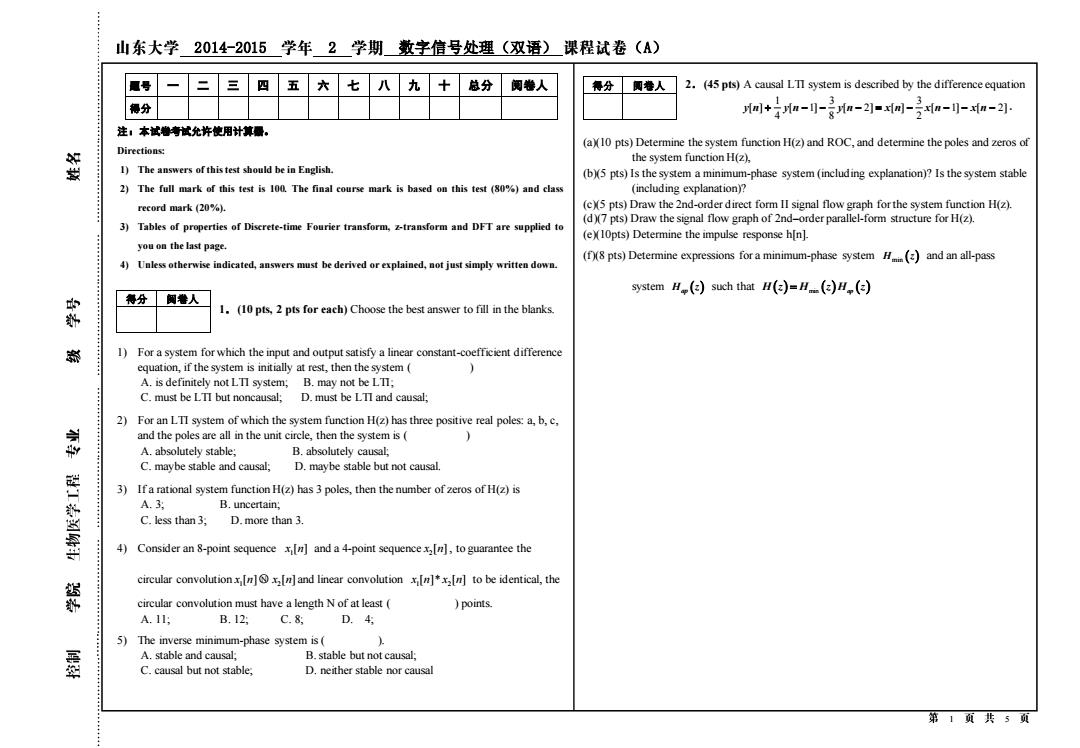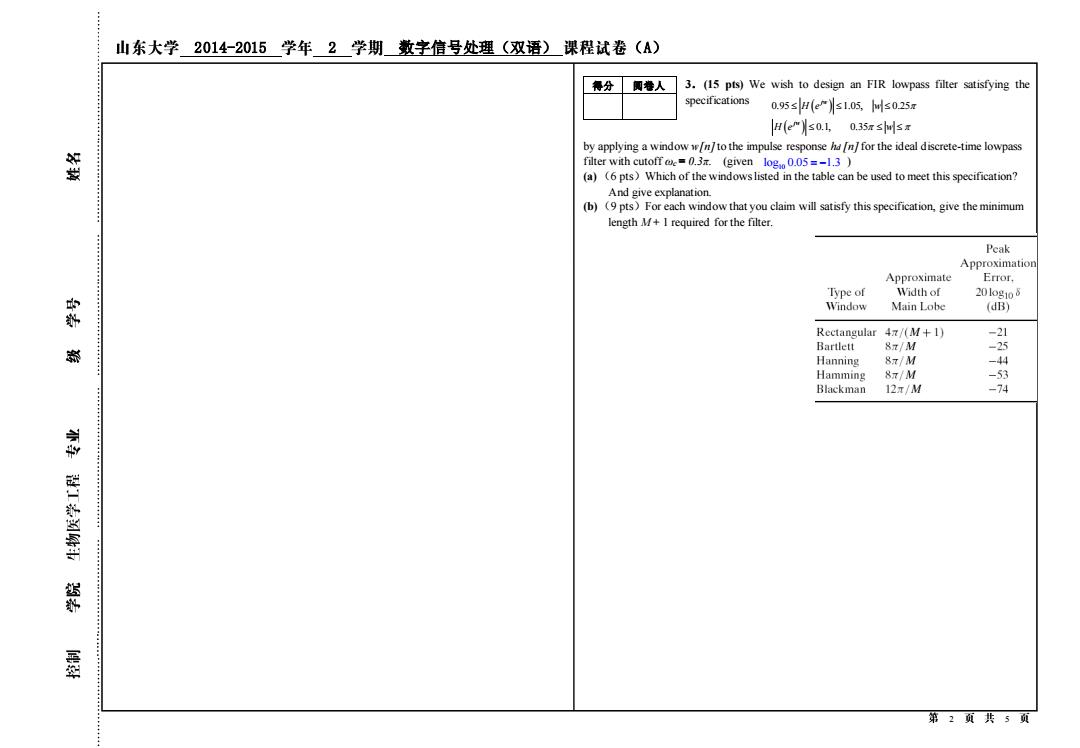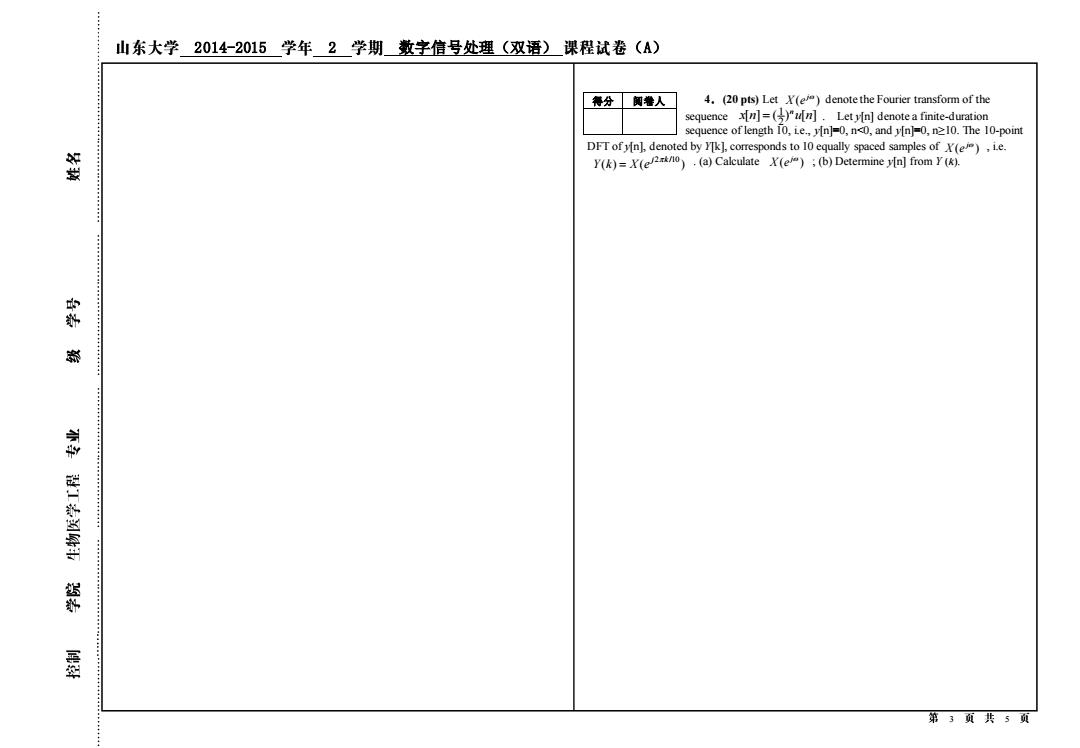
山东大学 2014-2015学年2学期数字信号处理(双语)课程试卷(A) 号 三 四 五 七 八九 总分 阅卷人 得分 港人 2.(45 pts)A causal LTI system is described by the difference equation 得分 +咖---2m--a-斗 注,本试物考试允许使用计算最。 (aX10 pts)Determine the system function H(z)and ROC,and determine the poles and zeros of Direetions: 好 the system function H(z), 1)The answers of this test should be in English. (b)(5 pts)Is the system a minimum-phase system (including explanation)?Is the system stable 2)The full mark of this test is 100.The final course mark is based on this test (80%)and class (including explanation)? record mark (20%). (cX5 pts)Draw the 2nd-order direct form II signal flow graph for the system function H(z). (d)(7 pts)Draw the signal flow graph of 2nd-order parallel-form structure for H(z). 3)Tables of properties of Discrete-time Fourier transform,z-transform and DFT are supplied to (eX1Opts)Determine the impulse response h[n] you on the last page. 4)Unless otherwise indicated,answers must be derived or explained,not just simply written down. (f)(8 pts)Determine expressions for a minimum-phase system H()and an all-pass system H()such that H(z)=H()H() 的 得分卷人 1. (10 pts,2 pts for eaeh)Choose the best answer to fill in the blanks. 1)For a system for which the input and output satisfy a linear constant-coefficient difference equation,if the system is initially at rest,then the system A.is definitely not LTI system:B.may not be LTI; C.must be LTI but noncausal:D.must be LTI and causal: 2)For an LTI system of which the system function H(z)has three positive real poles:a,b,c, 剑 and the poles are all in the unit circle,then the system is A.absolutely stable; B.absolutely causal; C.maybe stable and causal; D.maybe stable but not causal. 说 3)If a rational system function H(z)has 3 poles,then the number of zeros of H(z)is A.3: B.uncertain; C.less than 3;D.more than 3 4)Consider an 8-point sequence x[n]and a 4-point sequence x[n],to guarantee the circular convolutionx[]n]and linear convolutionx[to be identical,the 器 circular convolution must have a length N of at least( points A.11 B.12: C.8, D.4, 5)The inverse minimum-phase system is 暴 A.stable and causal; B.stable but not causal; C.causal but not stable, D.neither stable nor causal 第1负共5页
2014-2015 2 数字信号处理(双语) (A) 1 5 题号 一 二 三 四 五 六 七 八 九 十 总分 阅卷人 得分 注:本试卷考试允许使用计算器。 Directions: 1) The answers of this test should be in English. 2) The full mark of this test is 100. The final course mark is based on this test (80%) and class record mark (20%). 3) Tables of properties of Discrete-time Fourier transform, z-transform and DFT are supplied to you on the last page. 4) Unless otherwise indicated, answers must be derived or explained, not just simply written down. 1.(10 pts, 2 pts for each) Choose the best answer to fill in the blanks. 1) For a system for which the input and output satisfy a linear constant-coefficient difference equation, if the system is initially at rest, then the system ( ) A. is definitely not LTI system; B. may not be LTI; C. must be LTI but noncausal; D. must be LTI and causal; 2) For an LTI system of which the system function H(z) has three positive real poles: a, b, c, and the poles are all in the unit circle, then the system is ( ) A. absolutely stable; B. absolutely causal; C. maybe stable and causal; D. maybe stable but not causal. 3) If a rational system function H(z) has 3 poles, then the number of zeros of H(z) is A. 3; B. uncertain; C. less than 3; D. more than 3. 4) Consider an 8-point sequence 1 x n[ ] and a 4-point sequence 2 x n[ ], to guarantee the circular convolution 1 x n[ ] ○N 2 x n[ ] and linear convolution 1 2 x n x n [ ]* [ ] to be identical, the circular convolution must have a length N of at least ( ) points. A. 11; B. 12; C. 8; D. 4; 5) The inverse minimum-phase system is ( ). A. stable and causal; B. stable but not causal; C. causal but not stable; D. neither stable nor causal 2.(45 pts) A causal LTI system is described by the difference equation 1 3 3 [ ] [ 1] [ 2] [ ] [ 1] [ 2] 4 8 2 y n y n y n x n x n x n + − − − = − − − − . (a)(10 pts) Determine the system function H(z) and ROC, and determine the poles and zeros of the system function H(z), (b)(5 pts) Is the system a minimum-phase system (including explanation)? Is the system stable (including explanation)? (c)(5 pts) Draw the 2nd-order direct form II signal flow graph for the system function H(z). (d)(7 pts) Draw the signal flow graph of 2nd–order parallel-form structure for H(z). (e)(10pts) Determine the impulse response h[n]. (f)(8 pts) Determine expressions for a minimum-phase system H z min ( ) and an all-pass system ( ) H z ap such that ( ) min ( ) ( ) H z H z H z = ap 得分 阅卷人 得分 阅卷人

山东大学2014-2015学年2学期数字信号处理(双语)课程试卷() 得分侧港人 3.(15 pts)We wish to design an FIR lowpass filter satisfying the specifications 0.95s H(em)s1.05,lso25 H(em)s0.1,0.35sls by applying a window wnto the impulse response h/n/for the ideal discrete-time lowpass filter with cutoff c%e=0.3r.(given log 0.05=-1.3 (a)(6 pts)Which of the windowslisted in the table can be used to meet this specification? And give explanation. (b)(9 pts)For each window that you claim will satisfy this specification,give the minimum length M+I required for the filter. Peak Approximation Approximate Error. Type of Width of 20log108 器 Window Main Lobe (dB) Rectangular 4/(M+1) -21 Bartlett 8z/M -25 Hanning 8z/M -44 Hamming 8z/M -53 Blackman 12T/M -74 器 第2项共5页
2014-2015 2 数字信号处理(双语) (A) 2 5 3.(15 pts) We wish to design an FIR lowpass filter satisfying the specifications by applying a window w[n] to the impulse response hd [n] for the ideal discrete-time lowpass filter with cutoff ωc = 0.3π. (given ) (a) (6 pts)Which of the windows listed in the table can be used to meet this specification? And give explanation. (b)(9 pts)For each window that you claim will satisfy this specification, give the minimum length M + 1 required for the filter. 得分 阅卷人 ( ) ( ) 0.95 1.05, 0.25 0.1, 0.35 jw jw H e w H e w 10 log 0.05 1.3 = −

山东大学2014-2015学年2学期数字信号处理(双语)课程试卷() 将分侧撸人 4.(20 pts)Let Y(e)denote the Fourier transform of the sequencexn]=()"un].LetyIn]denote a finite-duration sequence of length 10,ie.,yin]=0,n<0,and yIn]=0,n210.The 10-point DFT ofyn denoted by YTk],corresponds to 10 equally spaced samples of Y(e),ie. 签 Y(k)=X(en).(a)Calculate X(e)(b)Determine y[n]from Y(). 琴 第3负共5页
2014-2015 2 数字信号处理(双语) (A) 3 5 4.(20 pts) Let denote the Fourier transform of the sequence . Let y[n] denote a finite-duration sequence of length 10, i.e., y[n]=0, n<0, and y[n]=0, n≥10. The 10-point DFT of y[n], denoted by Y[k], corresponds to 10 equally spaced samples of , i.e. . (a) Calculate ; (b) Determine y[n] from Y (k). 得分 阅卷人 ( ) j X e 1 2 [ ] ( ) [ ] = n x n u n 2 /10 ( ) ( ) = j k Y k X e ( ) j X e ( ) j X e

山东大学2014-2015学年2学期数字信号处理(双语)课程试卷(4) 得分港人 5.(10 pts)The figure below shows the flow graph for an 8-point decimation-in-time FFT algorithm.The heavy line shows a path from sample x7]to DFT sample X[21. X 都 o XT到 [3]o X[ 洲 7- (a)What is the"gain"along the path that is emphasized in the Figure above? (b)How many other paths in the flow graph begin at and end at X[2?Is this true in general?That is, how many paths are there between each input sample and each output sample? (c)Now consider the DFT sample X[2].By tracing paths in the flow graph of the Figure above,show that each input sample contributes the proper amount to the output DFT sample X2];i.e find the bin] (n=0,1,..,7)in the cquation: Xp]-之物 器 第4项共5页
2014-2015 2 数字信号处理(双语) (A) 4 5 5.(10 pts) The figure below shows the flow graph for an 8-point decimation-in-time FFT algorithm. The heavy line shows a path from sample x[7] to DFT sample X[2]. (a) What is the "gain" along the path that is emphasized in the Figure above? (b) How many other paths in the flow graph begin at x[7] and end at X[2]? Is this true in general? That is, how many paths are there between each input sample and each output sample? (c) Now consider the DFT sample X[2]. By tracing paths in the flow graph of the Figure above, show that each input sample contributes the proper amount to the output DFT sample X[2]; i.e., find the b[n] (n=0, 1, .. ,7) in the equation: 7 0 2 [ ] [ ] n X x n b n = = 得分 阅卷人

山东大学2014-2015学年2学期数字信号处理(双语)课程试卷(A) TABLE 2.3 FOURIER TRANSFORM PAIRS TABLE 2.2 FOURIER TRANSFORM THEOREMS Sequence Fourier Transform Sequence Fourier Transform 1. 1 X(ej) 2.m-o】 e-jono 好 y Y(el) 1.ax(n]+byin] ax(el)+bY(el) 3.1(-o0n←0∞) ∑2红e+2的 2.x(n-ndl (n an integer) e-junX(ejo) 4.an(al1 游 3.-d-n- 1-x可 10) TABLE8.2 or oo (if m<0) Properties of the DFT 5.a"uln] 1-a可 la lal Finite-Length Sequence(Length N) N-point DFT (Length N) 6.-ad-n-1] la<lal 1.x(n] XI周 2.x[n].x2ln] X:[).X2[] TABLE 3.2 SOME z-TRANSFORM PROPERTIES 说 3.ax[n]+bx2in] aX因+bXl附 Section Reference Sequence Transform ROC 4.X Nx[((-k))N] xin] X(2) Rr 5.x[((n-m))N] WmX[内 a X R 6.Wyx[n] X(-)》N X2(z) Rn N- 3.41 网+br aX(z)+bx2(z) Contains R:nR X内X2R 3.42 x[n -no] 刷X() R.except for the possible 器 ∑n(mxI(n-mjN m= addition or deletion of N-1 the origin oroo 8.x[n]x2In] x()x2((k-6)N] 3.43 网 X(z/zo) lzoRr 3.4.4 网 Rr.except for the possible 是 addition or deletion of the origin or oo 第5页共5页
2014-2015 2 数字信号处理(双语) (A) 5 5 Properties of the DFT